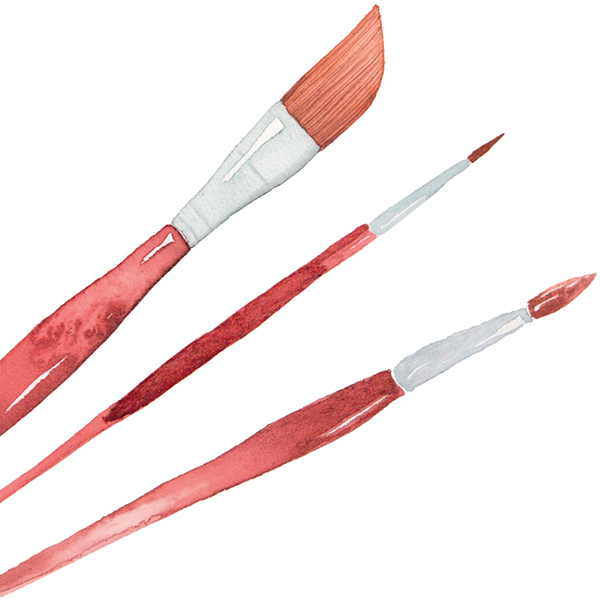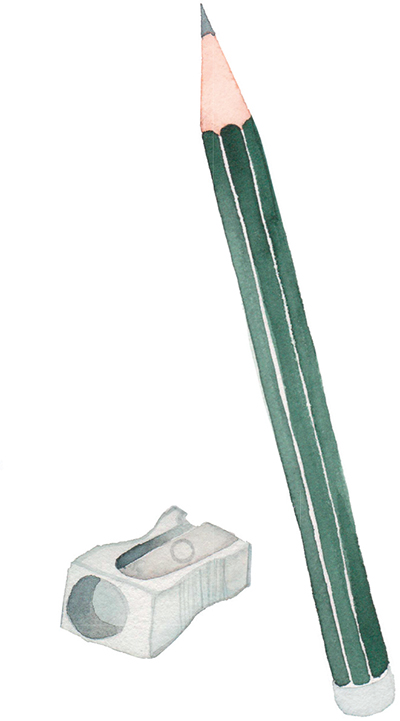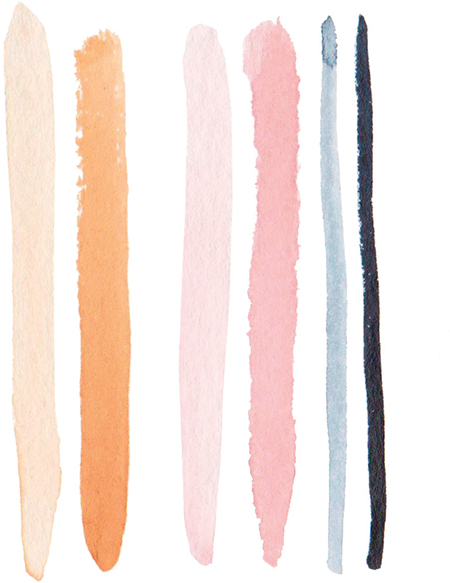
Getting started with watercolor does not require a lot of equipment. You will normally only need:

Considering the wide selection available and the differences in price, finding the right brush may seem daunting, but it does not have to be. Natural hair brushes are normally more expensive than synthetic ones. Your brush should essentially be capable of absorbing water well and holding it. It should be flexible and regain its shape after each brushstroke. It is also important that the fibers do not crumple up after the brush has been used for dabbing splashes of paint or drawing lines. There are basically two types of brush — round and flat. A round brush, where the fibers form a point, can be used to produce both fine and broad strokes, depending on how you apply the brush to the paper. This also applies to flat brushes, which are particularly suitable for larger areas such as backgrounds. Some of my favorites are the Cosmotop Spin series of round and flat brushes from da Vinci, which are very soft and don’t fray easily. Three or four brushes, ranging from fine to broad, should be enough to get you started on various projects. I recommend round brushes in size nos. 0, 3, 5 and 8 or 10.
Clean your brushes regularly under running water. This will keep them in good condition and ensure they last for a long time.
Choosing the right paper is extremely important. Above all it must be absorbent. The various types of paper are distinguished by their grain size, which in turn depends on the texture of the paper, and by the paper thickness, which is stated in grams per square meter. Lightly grained paper has a smooth surface, whereas coarse-grained paper is rough. Every type of paper has its advantages, so you should try them out for yourself. Coarse paper is obviously more structured, producing a color effect that is different from the more detailed work you can easily achieve on fine or smooth paper. The thicker the watercolor paper is, the easier it is to paint on, as it is more absorbent and less likely to curl up or lose its shape.
I like working with Hahnemühle Britannia watercolor paper, which has a density of 300g/m² in matt. This paper is about 200g/m² heavier than normal drawing paper, where the normal weight is 100–150g/m². It is extremely absorbent and robust, and it allows me to do any kind of watercolor painting, whether it’s delicate, detailed, or broadly expressive.
Watercolor pads that are glued on all four edges work extremely well, because the paper does not curl up when you are using a lot of water. Carefully separate the paper with a knife or ruler once the painting is dry.
You’ll need a pencil for your sketches. It’s best to use an HB pencil for this as it will give you a fine but clear line that’s easy to erase.
A soft rubber eraser is recommended as it is the least likely to damage the surface structure of the paper when used. I like using the Faber-Castell kneadable eraser.

An old cloth or some paper towel can be worth its weight in gold. For one thing, you can always wipe your brush on it. And what’s more, it helps you deal with minor accidents or disasters. If, for example, you have applied too much paint to a surface, you can easily dab it off or wipe it away with a cloth.
A clean brush is also good for wiping away unwanted paint.
Watercolors vary in quality and come in various forms, for example in pans or tubes. Single watercolors in tubes are more concentrated than the hard paint in pans. The latter has to be moistened with a wet brush before you start in order to release the paint, which is then automatically diluted. Whichever you choose is a matter of taste.
I used Schmincke watercolors in pans for the projects in this book. A small box of watercolors with a medium range of colors is enough to get started. Other colors can easily be mixed from the basic colors.
A few simple exercises can help you become more confident with the materials you’re working with. Try out brushes and paints on different types of paper. You will soon see how your materials react under different conditions and how much this can affect the results.
Dip any brush you like into clean water, to get it wet, and remove any excess water against the rim of the water container or with a cloth. The brush should be saturated with water but should not drip. Now moisten and absorb the paint from the pan with the wet brush, by moving the brush over the pan several times until the paint softens and permeates the brush fibers.
Draw a line with the brush. You might like to begin with the widest flat brush and work your way down to the finer brushes, drawing more lines with the other brush sizes as you go. You will find that fine brushes absorb much less paint than the broad ones.
